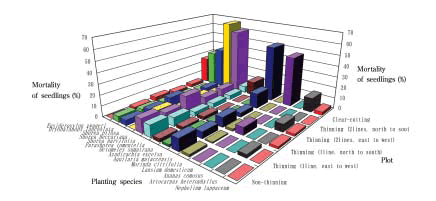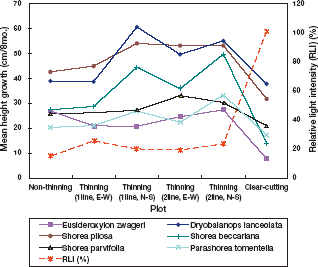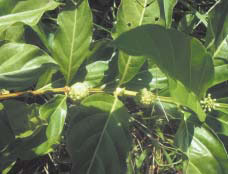Agroforestry experiment for rehabilitating tropical forests: Effects of forest canopies on initial seedling establishment and tending
Description
[Objectives]
We studied the initial survival and growth of various plant species including Dipterocarpaceae species, fruits trees species, medicinal plants etc. in Acacia mangium stand (1.6 ha) and secondary forest (2.9 ha) with thinning and non-thinning plots, and in cleared forest sites (2 ha) in eastern Sabah, Malaysia in 2002 and 2003 in order to clarify the suitable shading conditions on the initial establishment of various plant species in the process of establishing the mixed forests from A. mangium stand and secondary forest. The necessary degree of weeding, which is crucial for the productive growth of seedlings, was studied as well.
[Results]
The results obtained in the initial experiments are as follows:
1) A majority of the plant species had higher survival rates in thinning plots (RLI: 10 to 20%) and under canopies of exotic tree species than in cleared forest sites during the first 8 months after planting. In particular, Dipterocarpaciea species, except for Parashorea tomentella, showed much higher mortality rates in cleared forest plots (33 to 67%) than in thinning plots (0 to 16%) (Fig. 1).
2) Except for shade-intolerant tree species, including Octomeles sumatrana and some fruit tree species, most plant species including Dipterocarpaceae showed significantly higher growth rates in thinning plots than in cleared plots, and significantly higher growth rates in line thinning plots extending from north to south than line thinning plots extending from east to west (Fig. 2).
3) Morinda citrifolia (Fig. 3) came into bearing around eight months after planting in thinning plots as well as cleared plots. This medicinal plant species had a high growth rate in thinning plots as well as in cleared plots.
4) Based on the recorded amount of time spent on weeding, questionnaires on weeding conditions in various sites, and pulse rate measurements of people conducting the weeding, it was found that weeding time was around 40% shorter and weeding conditions became less harsh in thinning sites than in cleared sites.
These results suggest that moderate shade (RLI: 10-20%) cast by forest canopies may facilitate seedling establishment and reduce the amount of necessary weeding, and thus saving weeding costs in comparison with conventional planting in cleared forest sites. The results of initial monitoring also suggest that medicinal plant including Morinda citrifolia would be a useful companion species for sustainable medicinal fruit production in the establishment of sustainable mixed forests.
Figure, table
-
Fig. 1. Seedling mortality rates in thinning, non-thinning and cleared forest plots, eight months after planting. -
Fig. 2. Height growth of seedlings in thinning, non-thinning and cleared plots, eight months after planting. -
Fig. 3. Morinda citrifolia fruits in a thinning plot.
- Affiliation
-
Japan International Research Center for Agricultural Sciences Forestry Division
- Classification
-
Technical A
- Term of research
-
FY2003 (FY2000-2006)
- Responsible researcher
-
KAMO Koichi ( Forestry Division )
LAMALUNG Lenim ( Forest Research Centre, Sabah )
LAPONGAN Jaffirin ( Forest Research Centre, Sabah )
- ほか
- Publication, etc.
-
Kamo, K., Jamalung, L. and Lapongan, J. (2004): Agroforestry experiment for establishing mixed forests. Abstract of annual meeting of the Japanese forestry society, 115, 156.
Kamo, K., Jamalung, L., Ota, T. and Lapongan, J. (2004): How important are nurse-trees for reforesting tropical land? Abstract of Workshop on "Development of Agroforestry Technology for the Rehabilitation of Tropical Forests", Sandakan, Sabah, Malaysi, 13-16.
- Japanese PDF
-
2003_25_A3_ja.pdf2.29 MB
- English PDF
-
2003_25_A4_en.pdf83.46 KB



